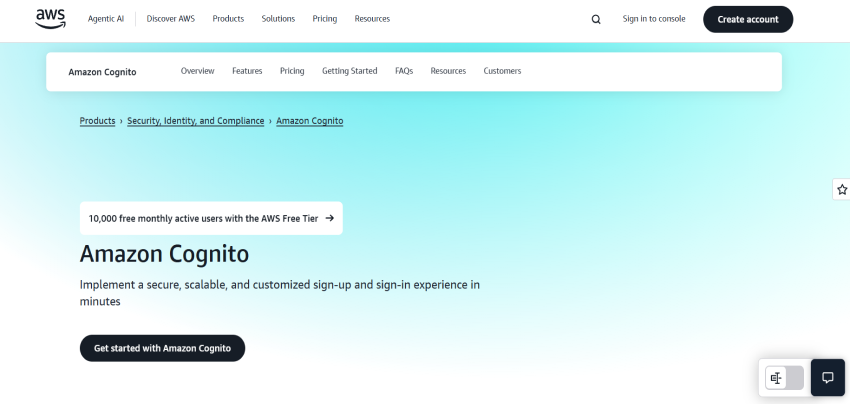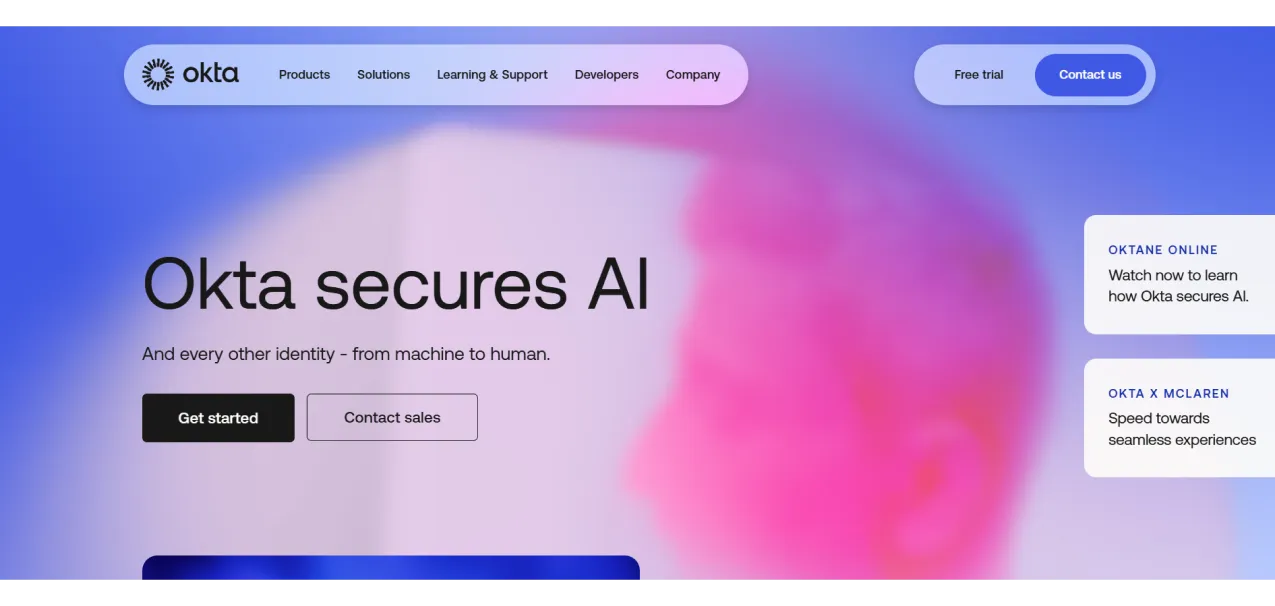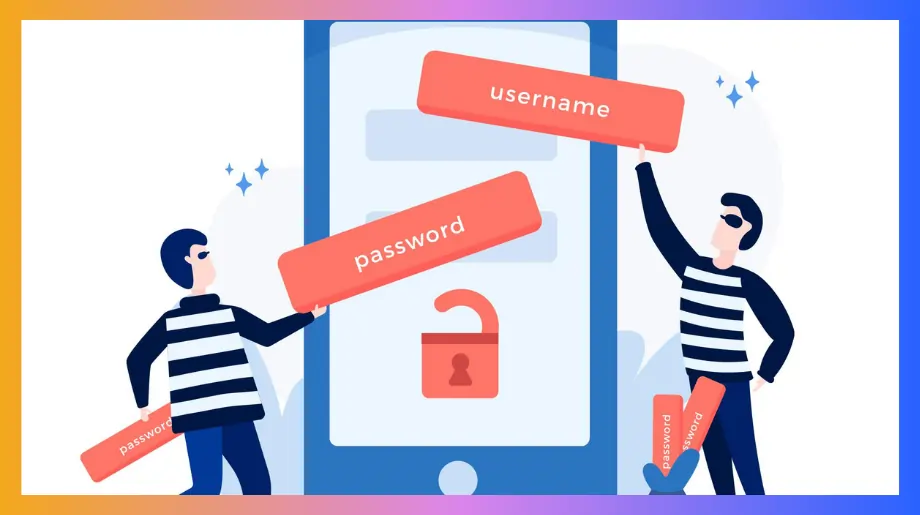Cyber incidents are no longer a question of “if,” but of “when.”
The identity and access management platform you select today determines whether tomorrow’s breach is a footnote in an internal report or a board-level crisis.
When comparing AWS Cognito vs Okta, both lead the talk, but each fits a different risk profile.
AWS Cognito is Amazon’s own service. If your code already lives inside AWS, Cognito snaps in quickly. Okta, by contrast, was born for large, mixed estates. It started as a single sign-on hub and grew into a full identity platform.
AWS Cognito vs Okta: A Detailed Comparison
What is AWS Cognito?
AWS Cognito is Amazon's service for managing user identity for web and mobile apps. It helps you add user lifecycle management features like sign-up, sign-in, and access control to your apps in minutes. You do not have to manage servers or infrastructure.

- Cognito has two main parts. User Pools handle authentication, and Identity Pools handle authorization.
- Identity Pools provide AWS credentials to your app, allowing it to access and provision resources to users through user provisioning and deprovisioning.
- It works with social logins like Google, Facebook and Apple. It also works with enterprise logins using SAML and OpenID Connect. Cognito can sync user data across devices and let mobile apps work offline.
- Cognito User Pool stores names, emails, and passwords. It handles sign up, sign in, reset, and MFA. It links Google, Facebook, Apple and SAML. You can add logos and colors. Data is encrypted and logs are ready. It scales from ten to millions. The first fifty thousand users each month are free.
What is Okta?
Okta is a service for managing identity and access for companies. It helps people log in to apps and devices safely through comprehensive identity and access management (IAM) software. Okta works for employees and customers of companies of any size.

- The platform provides single sign-on, multi-factor authentication, and user lifecycle management. Okta has a marketplace with thousands of ready-to-use app integrations. It works for both cloud and hybrid systems, providing strong identity control.
- In 2021 Okta bought Auth0. Now, for customer identity cases, Okta uses Auth0. It is ideal for large companies that require numerous integrations and robust security.
AWS Cognito vs Okta: A Detailed Breakdown for 2025
If your organization is choosing an identity platform, you need to think about more than just login. Each platform solves different business problems and works in different ways. When evaluating Cognito vs Okta, it also fits differently depending on how your company grows. Here we will look at both platforms and compare them on the most critical points to help you decide.
Key Features of AWS Cognito vs Okta
AWS Cognito Core Capabilities
- User Pools and Identity Pools. User Pools let people sign up and sign in easily. Identity Pools give your app temporary AWS access. You can use them together or alone, depending on your app.
- Social and Enterprise Login. Cognito works with Google, Facebook, Apple, and enterprise systems through advanced authentication methods. Users can log in with accounts they already have. This makes login easier and less frustrating.
- Mobile and Web SDKs. Cognito works on iOS, Android, JavaScript, and more. Apps can work offline. Tokens refresh by themselves, and sessions are handled automatically.
- Advanced Security. It watches for risky logins and adds extra checks when needed. It keeps your app and users safe.
Okta Core Capabilities
- Universal Directory. You can manage all users in one place across every app and service through identity governance and administration. Users get added or removed automatically from HR systems. You can control roles and permissions so everyone sees what they are supposed to.
- App Marketplace. Okta has thousands of ready-to-use app integrations. Single sign on works for cloud apps and apps on your own servers. You can even connect custom apps using SAML OIDC and APIs.
- Identity Governance. Okta keeps track of who can access what and makes sure it is correct. You can automate requests and approvals. Policies make access real time and help with compliance.
- Multi-Factor Authentication. Okta gives many ways to log in like biometrics, hardware tokens, and push notifications. It can also add extra checks if something looks risky or unusual.
Authentication & Federation Options
AWS Cognito Authentication
- Native User Management. You can sign up users and manage passwords easily. Login flows are simple and fit your app. Users can sign in with username, email or phone number.
- Single Sign On. Cognito User Pool can act as the single identity provider for many applications. Once a user logs in to one app the same session token can be reused by other apps that trust the same pool so users do not have to enter passwords again.
- Social Identity Providers. Users can log in with Facebook, Google, Apple or Amazon. Accounts with more than one login link automatically. Social profile info can be added to user data.
- Enterprise Federation. Enterprise Federation lets employees use their company login to reach your app. Cognito checks Active Directory or any SAML / OpenID Connect system so no passwords are copied. A short Lambda can add rules like “managers only.”
- Multi-Factor Authentication. Supports SMS time-based codes and software tokens. Users using SAML or OIDC above the free tier cost fifteen thousandths per user.
Okta Authentication
- Adaptive Authentication. Here, Okta checks who is logging in. It looks at the behavior device and location using attribute-based access control (ABAC). If something feels risky, it makes the login harder. Over time, it learns and gets smarter.
- Comprehensive MFA Options. You get many ways to secure a login including passwordless authentication. Biometrics hardware tokens, SMS, voice push, and more. It even supports passwordless login with WebAuthn and FIDO2. And if you need something special, you can build your own factor with APIs.
- Federation Standards. Okta supports SAML, OpenID Connect, and WS Federation. It already has many identity providers ready to use. If your company has a unique case, you can build a custom federation, too.
Security, Compliance & Governance
AWS Cognito Security
- Built-in Security Features. Cognito has password rules, account lockout, and brute force protection. All user data is encrypted during transfer and at rest. You can also connect with AWS CloudTrail to keep audit logs for IAM compliance.
- Compromise Protection. Cognito can detect leaked credentials from public breaches. If an account is at risk, the user gets a warning and must reset the password. It also connects with AWS security services for stronger threat detection.
- Compliance Support. Cognito supports industry standards such as SOC, PCI DSS, ISO, and HIPAA. It provides data residency controls to comply with local laws. Every login and access event can be tracked in audit logs.
Okta Security & Governance
- Zero Trust Architecture. Okta follows zero trust IAM principles and never trusts and always verifies. It continuously checks user behavior and device health. Policies change in real time when risk goes up.
- Identity Governance. Okta runs access reviews and certification tasks automatically. It identifies policy violations and resolves them quickly. It enforces the separation of duties so no one can misuse access.
- Regulatory Compliance. Okta supports rules like SOX and GDPR and HIPAA and other industry laws. It creates reports and audit trails automatically. It adds data controls to protect sensitive information.
Scalability & Performance
AWS Cognito Scalability
- Serverless Architecture. Cognito grows automatically and can handle millions of users. You do not manage servers. You only pay for what you use through cloud-based identity and access management. It is available worldwide through AWS regions.
- Performance Optimization. Cognito works with Amazon CloudFront for global delivery. It balances traffic automatically. It uses caching to make the response time faster.
- Mobile Optimization. Cognito lets mobile apps work offline. It syncs user data in the background across devices. Its SDKs are designed for strong mobile performance.
Okta Scalability
- Enterprise Grade Infrastructure. Okta supports large companies with millions of users and apps. It promises 99.99% uptime with its global data centers. It includes high availability and disaster recovery for enterprise access management solutions.
- Global Deployment. Okta operates in data centers worldwide to meet compliance requirements and enhance performance. It uses edge nodes to cut latency and improve user experience. It also offers regional data residency options.
- API Rate Limits. Okta gives high API rate limits for apps with heavy use. It can handle bursts during peak times. Enterprise customers can get premium support with even higher limits.
Integration & Ecosystem Fit
AWS Cognito Ecosystem
- AWS Native Integration. When comparing Okta vs Cognito, Cognito works smoothly with AWS services like Lambda DynamoDB and API Gateway. It handles credentials automatically so your app can access AWS resources. You can use CloudFormation templates to set up infrastructure as code. Best fit: teams that deploy inside AWS regions and want one-vendor billing.
- Developer Tools. Cognito works with AWS Amplify to build apps quickly. It provides CLI tools and SDKs for popular programming languages. Pre-built UI components make common login flows easy.
- Third-Party Integrations. Cognito works with popular development frameworks and platforms. It uses an API-first approach so you can make custom integrations. Community libraries and tools help you build faster.
Okta Ecosystem
- Application Marketplace. In the Okta vs AWS Cognito comparison, Okta connects to many apps and services. It gives strong security and full identity control. You get thousands of pre-certified integrations. Automatic provisioning and single sign on work for popular business apps.
- Developer Platform. Okta gives APIs, SDKs and developer tools. You can use sandbox environments for testing and building. Documentation and community support help you work faster. Best fit: organisations that mix cloud and on-prem apps across multiple vendors.
- Partner Ecosystem. Okta works with system integrators for setup and support. It partners with security and productivity vendors. The marketplace lets you add third-party extensions and custom features.
Customization & Developer Experience
AWS Cognito Developer Experience
- Infrastructure as Code. When evaluating Amazon Cognito vs Okta, Cognito works with CloudFormation and Terraform to deploy automatically. You can track changes with version control. You can promote environments and roll back if needed.
- Custom Authentication Flows. You can use Lambda triggers to create custom login logic. You can add pre and post-authentication hooks for your business rules. You can create custom challenge types for unique login requirements.
- UI Customization. Cognito lets you change the hosted UI with CSS and branding. It gives pre-built UI components for popular frameworks. You can build a fully custom UI using SDKs and APIs.
Okta Developer Experience
- No-Code Low-Code Configuration. You can handle most setup tasks from the admin interface. Workflows can run automatically without coding. Visual policy builder helps set access rules easily.
- Advanced Customization. Okta gives open APIs so you can change login screens and add your own rules. Non-human identities are machine accounts like service bots, API keys, and IoT devices that need to sign in without a person. You create these identities in Okta, give each one a name and secret set rules on what it can open, rotate the secret often and keep a full log of every sign in.
- Developer Resources. Okta has full documentation and tutorials. Sample apps and code examples help you get started. Community forums give support and answers quickly.
Pricing Structure
AWS Support and Pricing
AWS offers pay-as-you-go billing and four support tiers that scale from free billing help up to enterprise-grade 24/7 technical account managers, so you only pay for the identity resources and assistance you actually use.
AWS Pricing Structure
- Cognito free tier: 50,000 MAU
- Above 50k: ~$0.005 per user
- SAML/OIDC users: $0.015 each
- Support tiers: $29–$15k per month
Okta Support and Pricing
Okta provides online help and phone assistance and assigned account managers and 24/7 coverage on higher tiers plus best-practice guidance to make system setup and ongoing management much easier.
Okta Pricing Structure
- SSO starter: ~$2 per user
- MFA add-on: ~$3 per user
- Lifecycle bundle: ~$6 per user
- Enterprise: $12+ per user (includes privileged access management)
Use Cases of AWS Cognito and Okta
AWS Cognito Ideal Use Cases
- Mobile-First Applications. In the AWS Cognito vs Okta evaluation, Cognito works well for native mobile apps. Apps can work offline. You can add social login for consumers. User data can sync across devices.
- AWS-Native Development. Best for apps built entirely on AWS. Works well with serverless architecture using Lambda and API Gateway. Suitable for projects where you pay only for what you use.
- Developer-Controlled Environments. Teams that like a code-first setup will benefit. Organizations with strong AWS knowledge do well. You can create custom login flows using Lambda.
Okta Optimal Use Cases
- Enterprise Workforce Identity. In the Cognito vs Okta comparison, Okta works well for large companies with many apps. It is strong for industries that need strict governance. You can connect HR systems for automatic user setup and removal.
- Multi-Cloud Environments. Okta is good for organizations using many cloud providers and on-premises systems. You can connect to lots of third-party apps. It supports hybrid deployments.
- Identity Governance Focus. Okta is strong for companies that need full access reviews and certifications. It helps meet compliance rules and keeps detailed audit logs. Good for large scale identity programs.
Limitations and Challenges of Okta vs Cognito
AWS Cognito Limitations
- Complex Configuration. Setting up Cognito can feel confusing if you are new to AWS. Authentication federation and access options need careful setup. Advanced features take time to learn.
- Limited Customization. You can only create up to 25 custom fields. UI customization is limited compared to other platforms.
- AWS Ecosystem Lock-in. Cognito works best inside AWS. Custom changes can be tricky. Moving to another platform is difficult.
- Token Management. Cognito tokens like ID Access and Refresh have short lifespans. When they expire users can lose access to protected resources.
Okta Limitations
- High Cost Structure. Okta charges per user. Costs rise quickly for large user bases. Higher-tier features cost more. Professional services add to total expense.
- Over-Engineering Risk. Okta has many features. Simple use cases can feel overwhelming. Advanced features make setup more complex than needed.
- Vendor Dependency. You rely heavily on Okta and its roadmap. Moving to another platform becomes harder. Custom development may be limited by platform rules.
- Learning Curve. Admin setup can be complex. Policies are tricky for new users. Advanced features need identity management knowledge.
Infisign: A Unified Alternative to AWS Cognito and Okta
Infisign protects what matters most. One account should never risk your business. With IAM Suite, you manage all employee identities securely—removing passwords and using tokens that expire after every session. Each login is unique and safe.
With UniFed, you unify all customer logins and directories in one place. You can see every customer account, partner, and device in a single dashboard, making access seamless and secure.
The idea is simple to understand yet powerful in practice. Every feature is built to reduce risk, improve user experience and simplify the work any team has to do.
- Passwordless Authentication. Infisign passwordless authentication replaces passwords with device bound passkeys and biometrics. Each login is unique and expires quickly. The method blocks phishing and brute force attacks from day one and cuts help desk tickets in half.
- Zero Trust Security. No request is trusted automatically. The system checks device health location and behavior at all times. Risky attempts are challenged or blocked. Attackers are stopped before they gain entry. Security stays adaptive and alive instead of rigid and reactive.
- Universal Single Sign On. Infisign sets up Universal SSO in under 4 hours. One secure identity opens cloud native, hybrid, and legacy apps without custom code. Users sign in once and work. Partners and suppliers can be added in minutes and they follow the same rule set without extra work. The setup wizard guides you through each step and live chat stands by if you need a hand.
- Multi Factor and Adaptive Authentication. Infisign Multi-Factor Authentication adds a quick second step to every login. Users can press Allow on their phone or show their face and the system picks the easiest safe way so work keeps moving. Adaptive Authentication runs in the background and checks location, device and time. If the login looks normal it keeps the step small. If the login looks odd it asks for a face scan or a key.
- Decentralized Identity and Reusable Credentials. Traditional systems place everything in one central database. Infisign gives control back to the user. Data is shared only when required. Credentials can be reused across systems without repeating forms or registrations. Privacy speed and trust rise together.
- Automated Lifecycle Management. Access changes follow real time events from hiring to role updates to offboarding. Directory and HR integrations keep records in sync. Permissions are adjusted automatically as business needs evolve. This prevents access creep and removes the weight of manual cleanup.
- Conditional Access Policies. Context becomes part of every login. Location device and time of day are all checked. Suspicious activity is blocked on its own. Real users move forward without delay while brute force and bots are filtered away.
- Compliance and Governance. Support for GDPR, HIPAA, SOX, and CCPA comes built-in. Every action is logged and audit reports generate instantly. AI driven governance handles certifications in the background. Regulatory checks that once took weeks can now be finished in hours.
- Privileged Access Management. Infisign PAM hands out admin keys that last only for the job. When the task ends the key vanishes. You get a full log of who opened what and for how long. Alerts appear if rights sit unused. No one keeps forever power and the audit trail builds itself. Risk drops and reviews stay simple.
- 24 by 7 Security Monitoring. The system never stops watching. Activity across users and devices is tracked all day and night. AI spots unsafe patterns early and responds before issues turn critical. Logs are created in real time and compliance reports stay ready.
- Scalability and Integrations. Infisign works for ten users or ten million. It plugs into 6000+ like sales and finance tools through ready-made links. You can start small and grow big without buying new servers. Old systems and new clouds follow the same rules so nothing breaks when you expand.
- AI Access Assist. Infisign AI monitors every login and learns normal usage patterns. Safe logins are approved automatically. Medium risk logins prompt a verification tap. High risk logins are blocked and an alert is sent to administrators. Users can also request access through Slack or Microsoft Teams. The AI continuously updates itself to detect new threats. Teams receive fewer false alarms and users gain faster access while maintaining strong security.
- Non-Human Identity Management. Infisign gives every service bot, API key, and IoT device its own login. Each credential is short lived and rotates on its own. You set rules that say which service can open which door. Every move is logged for audits. When the job ends the credential dies so there are no leftover secrets. Workloads move from test to prod without extra hand work and the attack surface stays small.
Cognito and Okta keep passwords in the background even when they add passwordless options. Infisign builds every login without passwords and puts Zero Trust at the core. Deployment finishes in hours not months.
The result is security that is stronger and an experience that feels natural. Businesses gain safety and simplicity together. Users gain a login journey that finally works.
Ready to experience the future of digital identity? Book your personalized demo now and see how Infisign can transform your organization's security and user management.
FAQs
What are the disadvantages of AWS Cognito?
AWS Cognito can be hard to set up for beginners. Its authentication federation and access options are complex. You can only create 25 custom attributes. The Amplify module is large. Cognito locks you into AWS. Token management can be tricky. Custom configurations are limited and migrating to another platform is difficult.
Does AWS Cognito use OAuth?
Yes, Cognito uses OAuth 2.0. It also works with OpenID Connect and SAML 2.0. Cognito can give OAuth tokens to your apps. You can also connect it to Google, Facebook, or enterprise login systems. It supports standard OAuth flows, including authorization code, implicit, and client credentials.
What are the best alternatives to Okta?
Some good alternatives to Okta are Infisign, Microsoft Entra ID, Auth0, Ping Identity, and SailPoint. Infisign removes passwords completely. Microsoft Entra works well if you use Office 365. Auth0 gives many tools and APIs for developers. Ping Identity is strong for a big company federation. SailPoint helps with identity governance and compliance. Each one has different strengths.
What are the best alternatives to AWS Cognito?
Some good alternatives to AWS Cognito are Infisign, Auth0, Firebase Authentication, Okta, and Supabase. Infisign removes passwords and boosts security. Auth0 gives many tools and customizations for developers. Firebase works well with Google Cloud apps. Okta is strong for enterprise identity. Supabase is open source and flexible. Each platform fits different business and technical needs.






















